29 Best Trout Flies: Modern Flies Used By River Guides
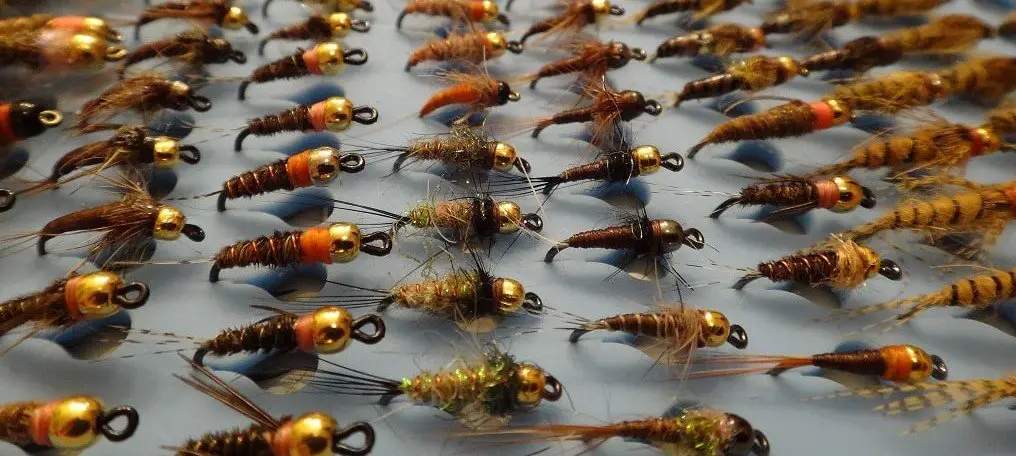
Some of the best trout flies are found in the boxes of fly fishing guides and competition fly anglers. I’m going to let you in on what flies the trout guides and competition anglers are actually using and why they are different from what most anglers use.
Effective flies for trout include nymphs, dry flies, and streamers. Emergers and wet flies are also options.
Common Flies For Trout Include:
- Hares Ear Nymph – Includes the Gold Ribbed Bead Head Hares Ear Nymph Pattern.
- Prince Nymph – This is a good versatile, all-purpose attractor pattern.
- Pheasant Tail Nymph – One of the best general imitation nymph patterns.
- Stonefly Nymph and Dry Fly – Great for rivers with stoneflies. Many versions of these are available.
- Caddis Larva and Elk Hair Caddis Dry Fly – This is one of my best-producing trout flies. I will show you my favorite.
- Woolly Buggers – a great all-purpose streamer for nymphing or streamer fishing.
- Adams – includes the Parachute Adams.
- Royal Coachman – My most effective brook trout dry fly pattern.
- Stimulator – A good attractor pattern to imitate large insects such as stoneflies or grasshoppers. Trout are known to target large insects.
- Copper John – A popular weighted nymph
- March Brown Dry Fly – A great early-season mayfly imitation.
But do guides and competition anglers actually use these flies? And if so, are they their most effective trout flies? The short answer is no.
As a guide myself who networks with many other guides to share fly patterns, it has been my experience that the flies found in the boxes of the top guides are not the same generic trout flies that most anglers use or what is recommended.
The Best Trout Flies Used By Guides
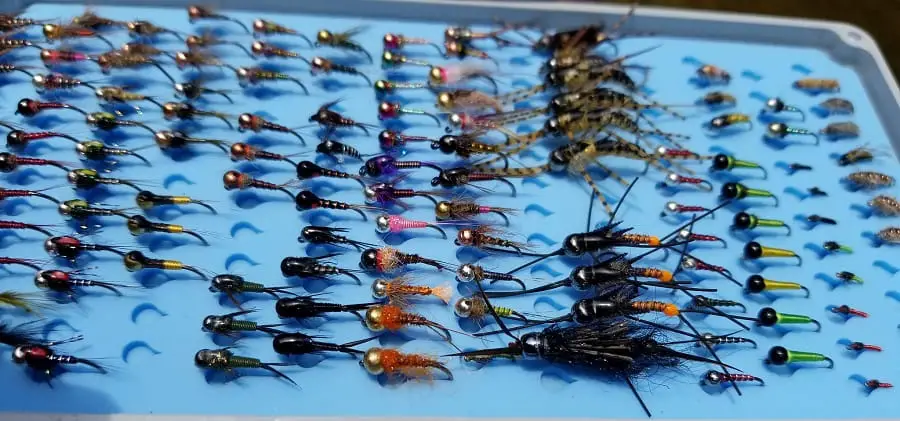
Guides have been testing flies for years, and they test them in all kinds of conditions so they get to know what works and what doesn’t.
Competition anglers generally have a community of other competition anglers. They also have coaches, team members, and mentors, and they learn from each other to keep improving and evolving faster. Part of that learning and evolving includes sharing their best flies with others.
In fact, in my opinion, competition anglers are often the most skilled fly anglers there are, and they are even more skilled than most trout guides.
I have had the opportunity to look into the boxes of many guides and top competition fly anglers.
I’ve even looked into the fly boxes of a world champion fly angler as well as the head coach for Fly Fishing Team USA, and I’ll tell you this, their fly boxes look very different from the average fly angler’s fly box.
An average angler’s fly box is often full of generic fly patterns because the average angler takes advice from stores and websites and other average anglers.
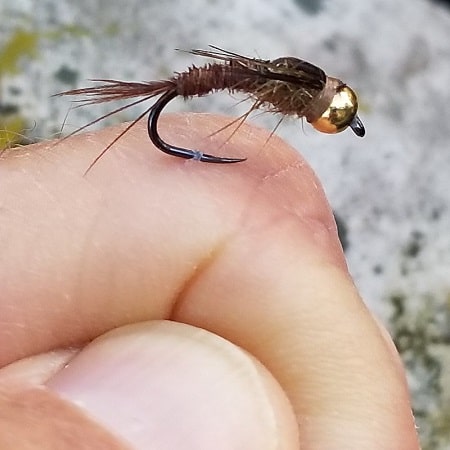
Even the books and articles that are written by the world’s best modern-day fly anglers don’t have the same generic trout flies that most websites and stores claim are the best flies for trout.
If those generic flies were really as good as the websites and stores say they are, wouldn’t the best competition anglers and the best guides have boxes full of them?
Some of the trout flies that I recommend on this page will be the exact same as what guides and competition anglers are using, while others might be just very similar, but they should work equally as well.
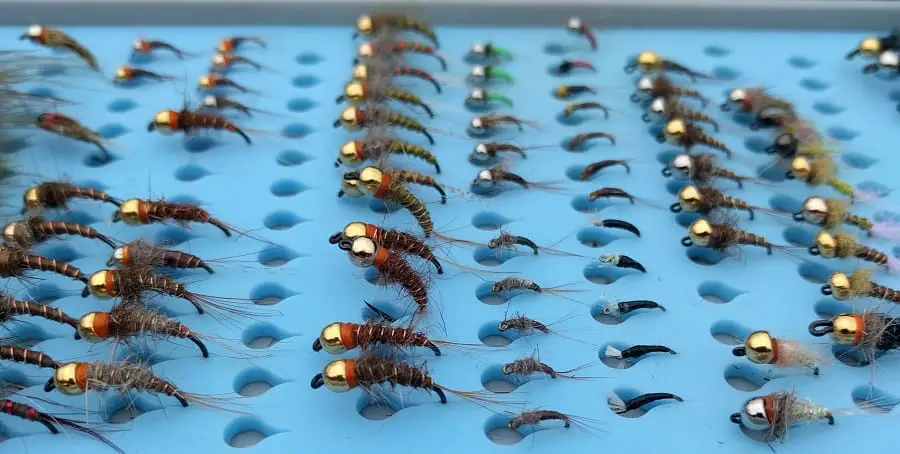
Trout Flies By Catagory
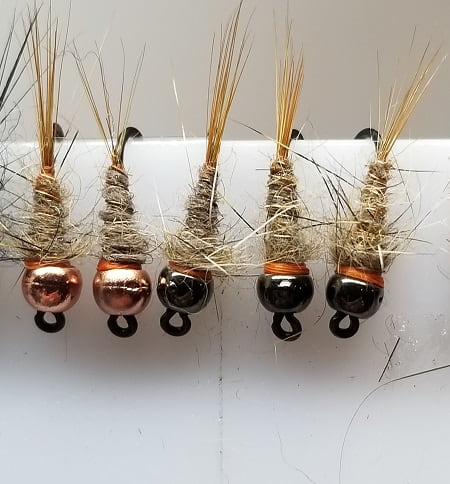
As a guide, one of the first things I do, when I get to the river, is to assess the conditions and then try to make an educated guess of what the best type of trout fly will be.
If I see rising fish, I will consider a dry fly over a nymph, but if it just rained and the river is flowing fast and slightly off-colored, I know this is a good time to catch big trout on streamers or nymphs.
All-day long I will try to determine what the fish are doing and feeding on and what the best fly patterns are, based on what I see.
That is why it is important to have a good selection of flies, which include dry flies, nymphs, and streamers.
Tying your own flies saves you money and lets you tie custom flies that will probably work better. If you are thinking about starting to tie your own flies, check out 5 Best Fly Tying Kits From Beginner to Advanced.
The Best Flies For Nymphing
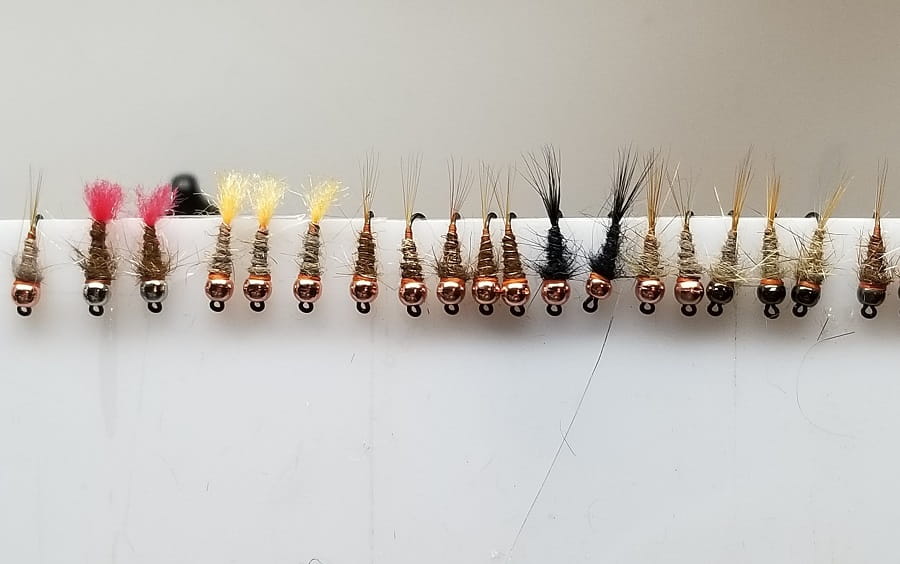
Nymphing has been my specialty for a long time, and I love it because it consistently produces large trout, steelhead, and salmon. Nymphs will generally work on any size or type of trout river.
When nymphing, the traditional indicator nymphing method is what most anglers use. However, some guides and all competition anglers will recommend and use Euro Nymphing methods simply because it’s more effective in a lot of situations.
Both methods have their pros and cons, and the anglers who are good at both methods and know when and where to use each method will catch ten times more trout.
Best Nymphs For Trout Fishing
1. Pheasant Tail Nymphs And 2 Great Variations
The Pheasant Tail Nymph is one of the few traditional nymphs you will see mentioned on other websites and you might still see it in some guide boxes for the simple reason that this is and always will be one of the best flies for trout.
The Pheasant Tail Nymph can be tied with or without a bead-head and it can also be tied as a flashback Pheasant Tail Nymph.
The Pheasant Tail Nymph can be a great trout fly when tied the traditional way but it is more common for guides and competition anglers to use other variations of it.
Some of these more modern variations I think are even better than the original pattern and I will discuss them below.
2. Polish Pheasant Tail Nymph
The Polish Pheasant Tail Nymph is a guide and competition-level fly tied by expert fly tier Davie McPhail, and it is one of the most effective flies for trout that I have ever used for trout and for steelhead.
Tied as is in the video, it represents many brown nymph species that you would find in a river or stream.
I have also tied this fly pattern in an all-black version, which replicates a black stonefly nymph quite well.
I have seen this fly in other guide boxes, and it is used by competition fly anglers. I have also shared this fly with many guides and many of my clients, and it’s proven very effective.
3. The Frenchie Nymph
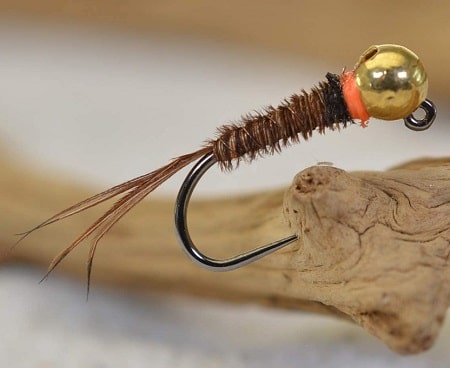
The Frenchie is an all-time favorite of many anglers, guides, and competition fly anglers.
I believe this fly was invented by one of Fly Fishing Team USA’s best competition anglers Lance Egan and it’s proven to be one of the most effective trout flies.
It is basically a legless pheasant tail nymph with a hot spot.
Since it is so effective it is now very popular and you can even purchase this fly at many fly shops or online.
When I first heard about how good the Frenchie fly was and then I saw how basic of a trout fly it was, I thought there is no way this fly would be better than the original Pheasant Tail Nymph.
I was a believer that a good fly for trout needed to have the shape and size of a real nymph. I felt a good trout fly should have a silhouette that resembles a nymph which means, legs, a thicker upper thorax, and a nice split tail.
This silhouette is found on the original Pheasant tail which is why it is so effective, but you don’t get that silhouette on the Frenchie, yet it still works fantastic.
I learned quickly that the Frenchie might be one of the best fies for trout ever created and it was so effective that it became my favorite fly the first year I started using it. It worked equally well for small and large trout.
It also became a favorite trout fly of many of my clients and other guides that I shared it with.
After lots of thought as to why the Frenchie is so effective despite not having the shape of a fly, I have determined that the Frenchies’ thin profile gets down and deep fast and it stays down in the strike zone.
And since trout sample all kinds of stuff that they shouldn’t put in their mouths, stuff like bark, seaweed, leaves, twigs, and pebbles, they sample the Frenchie too when it drifts by them.
I have seen and tried the Frenchie in many variations using different hot spots or collars, as seen in the video, but I almost always find the original to be the best. I also find that thinner is better than thicker.
I have also done well with a black and tan version of the Frenchie Nymph, and instead of using Pheasant Tail as it was meant to be tied, I also use dubbing for the body since it makes the fly more durable.
4. Hare’s Ear Nymph Variations
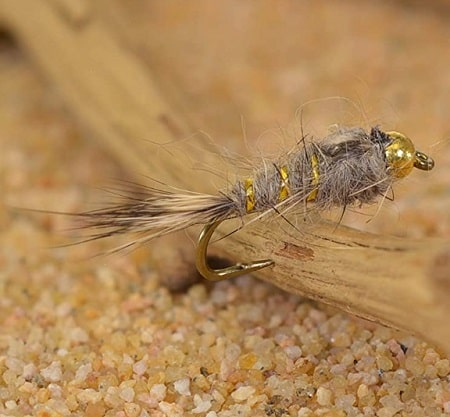
Hares Ear Nymph:
The standard Hare’s Ear Nymph is often on many top ten lists as one of the top trout flies, however, I rarely use the originally tied version anymore and don’t see it in many guides fly boxes or competition anglers’ fly boxes.
Instead, you will often see variations of the original Hares Ear Nymph simply because I think they work better.
I’m not saying the original version of the Hares Ear Nymph or the Bead Head Hares Ear Nymph are not good flies, it’s just that based on my experience there are a few variations that I have found to be much more effective.
5. The DM Hares Ear Nymph
The DM or Davie McPhail Hares Ear Nymph:
This is a very effective variation of the Hairs Ear Nymph but it’s thinner and Davie has added legs. I find this fly to be a lot more effective than the traditional Hares Ear Nymph.
Add a bead head of gold, silver, or copper and it can be even better.
This is almost a combination of a Pheasant Tail Nymph and a Hairs Ear Nymph. Either way, it’s very effective.
Sorry guys but this is one fly that you will either need to tie yourself or have someone tie it for you.
6. Tag Hairs Ear Nymph
I believe tag-style flies were invented by European competition anglers and now tag flies have quickly become many fly guides and competition anglers’ best fies for trout and are one of my most effective trout flies.
The tag refers to the bright-colored tail and believe it or not, it works. My preference for tag color is light pink and orange tails, but I have done well with yellow, white, and red.
I have been using tag flies for about five years, and they are excellent for all trout. You can buy them from The Fly Fiend, or you will either need to tie them yourself or have someone tie them for you.
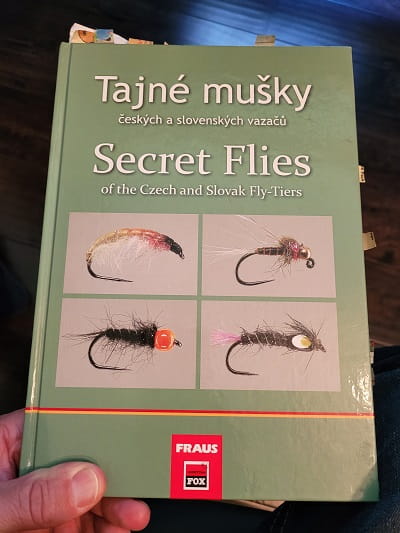
I first saw this style of fly in a book called Secret Flies of the Czech and Slovak Fly-Tiers.
This book features top flies from over 20 competition anglers and is a fantastic read if you can get a copy.
This book is hard to get, and it might become a collector’s item someday. It is worth a lot of money, so get it while you can.
A little tip for you guys. If you want to buy this tag fly or you want custom-tied flies that are competition quality, one of the best tyers and websites is The Fly Feind. I have used many of his flies tied by him. I am not affiliated with him at all, he just ties amazing flies and has a great selection.
7. The Walts Worm and Sext Walts Worm
The Walts Worm is a simple but very effective pattern used by guides and competitive anglers.
The sexy Walts Worm is a flashy version with a red or orange hotspot and is used by many great anglers.
This is a great imitation for some caddis, cased caddis, and crane fly larvae. As it becomes more beat up, it can resemble other nymphs. Whatever it looks like to a trout, they love this fly.
As far as I am concerned, the Walts Worm and the Sext Walts are two of the best trout fly patterns available and a must-have fly in anyone’s box.
If you are interested in purchasing these flies, click the links. Walts Worm and Sexy Walts Worm.
You can also get it at the Fly Fiend.
8. Blow Torch Fly
The blow torch is a new but popular fly with guides and competition anglers.
I believe it was designed by top competition angler Deven Olson.
I have been using this fly over the last few years and it is excellent for all species of trout and in all types of water.
It has also become a favorite steelhead fly for me and my clients.
9. The Lint Fly – Scud / Isopod
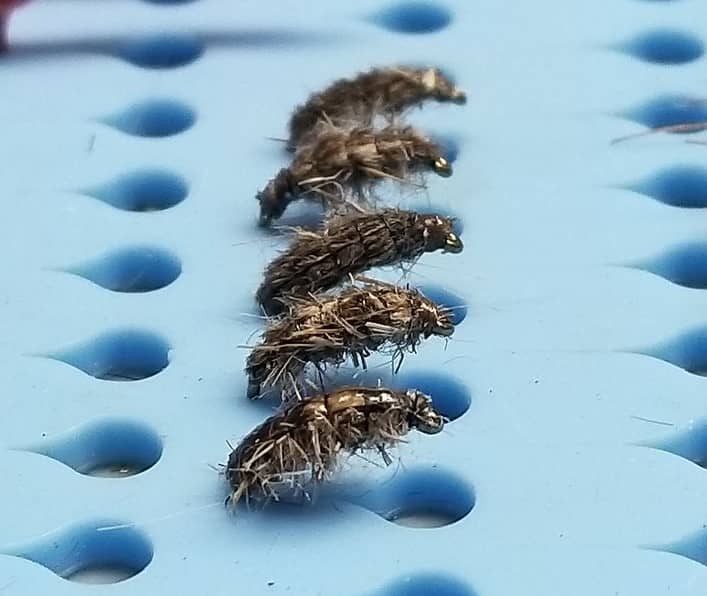
The Lint Fly imitates an Isopod or scud, and it got its name after my client landed a big 25-inch brown trout and said he couldn’t believe a size 18 fly that looks like lint from his belly button could catch such a big trout.
He asked me what the name of it was and I said it doesn’t have a name, however, from this point on I will call it the Lint Fly.
Since you can’t buy the Lint Fly, there are very similar and effective patterns, such as the Diamond Dub Scud, or an almost exact copy of the Lint Fly is the Wood Duck Scud.
Instead of wood duck for the back, I use is mottled Turkey feather and the body is made of a blend of Hares Ear Dubbing and deer hair which is trimmed short and to shape after tying. The deer hair looks a lot like legs.
I also use a 4x to 6x tippet to rib the fly and hold it all together.
10. Stonefly Nymph
Stonefly patterns are important to have in your box and you will find variations of stoneflies in a fly guide’s boxes.
I always have small tiny black stoneflies like the “Two Bit Hooker” for early in the spring, and will also have brown stoneflies and golden stoneflies for later in the season.
11. APD Caddis: Caddis Larva and Pupa
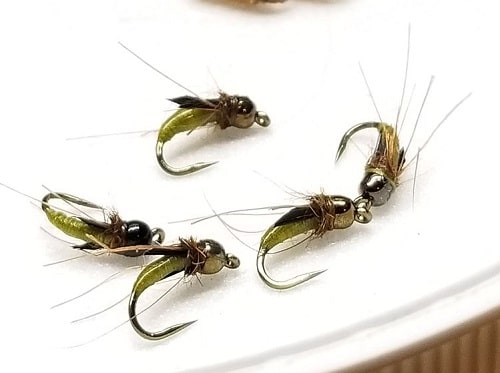
Most rivers have caddis so having a good caddis larva and caddis pupa pattern is important.
The picture is my personal APD Caddis and it is a very effective fly for me and the clients and guides that I have shared it with.
Since it’s a custom-tied fly that you would need to tie yourself and one that you can’t buy, the closest and still very effective fly is the McPhail Caddis Pupa or the Super Stretch Caddis Pupa.
Other Great Nymphs
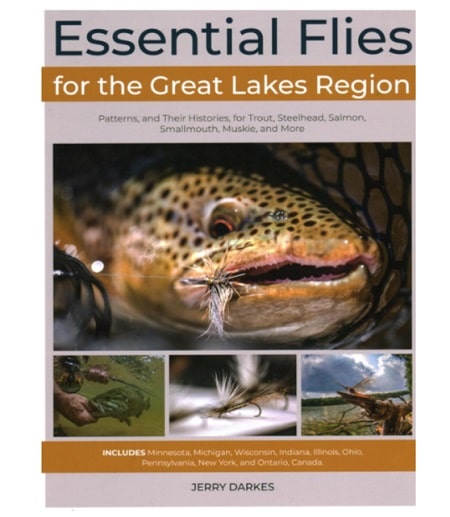
One of the best nymphs not mentioned yet but is a must-have in any fly box is the San Juan Worm in red, pink, and brown.
If you live around the Great Lakes Region, be sure to check out Jerry Darkes book Essential Flies for the Great Lakes Region
Perdigon Flies
Perdigon flies are becoming very popular, and for good reason, they work
They don’t look like much, but they sink fast and stay in the strike zone. They are a unique fly with only a tail, a hard epoxy body, and a bead.. that’s it!
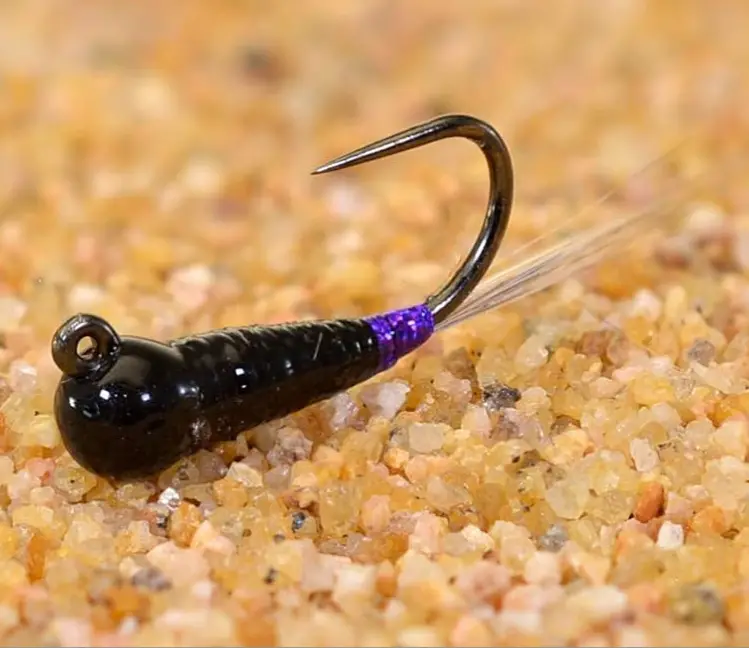
And since I don’t think trout are all that smart and will put just about anything in their mouths, I think this fly creates enough curiosity to get them to bite it.
Perdigons can be brightly colored with all kinds of color combinations or darker, more natural colors.
The Best Trout Flies For Dry Fly Fishing
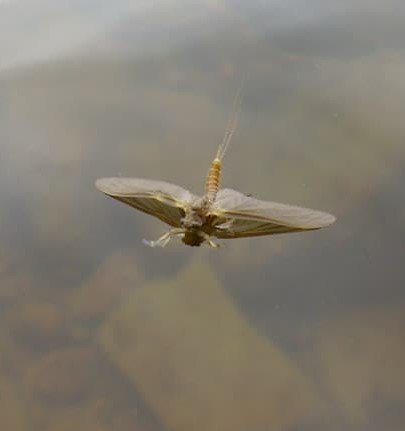
There are four types of dry flies to consider, but there are thousands of dry fly patterns.
It is my experience that fly tyers and fly anglers overcomplicate dry flies with all the different patterns.
Therefore, I will try to simplify things and show you the most effective types of flies without needing hundreds of patterns.
When it comes to dry flies, you need:
- Mayfly Dun Pattern
- Mayfly Spinner Pattern
- Caddis Pattern
- Terrestrials
- Stonefly Pattern
- Attractor Patterns
12. Mayfly Dun Pattern
There are hundreds of mayfly dun patterns, but you will often find the same type of patterns in the boxes of guides. I use the same three styles except that I change the size and the color to match the hatch.
I do this because, for the most part, all mayfly duns have the same shape, so there is no point in having a different pattern for each mayfly. A simple pattern like the Rough Olive seen in the above picture will imitate all mayflies if you change the body, wings, hackle colors, and size to match the hatch.
I have tested this out, and it works all the time. I’m not saying other patterns won’t work; I’m just saying that keeping it simple also works.
Tie this fly with double the hackle for faster riffle water and it will float a lot better, or tie it more sparsely for slow flat water and you will fool more trout.
13. Comparadun Mayfly
The Comparadun Mayfly is another fly you will find in many guide boxes. Tied with CDC or deer or elk hair both work.
Then change the size and color to match the hatch for all the different mayflies near you and you are good to go.
One thing I noticed about many store-bought dry flies is that they use cheap hooks and often they use hooks with a small gap. They are also tied with thick bodies which close up the gap and this makes it hard to get the hook set when a trout grabs it.
I use wider gap hooks for a better hooking percentage, and many guides will know this and tie their dry flies similarly.
If you don’t tie your own flies and want good quality dry flies, check out Reel Flies, The Fly Fiend, or Region Fishing. Two great North American fly-tying shops.
14. Elk Hair Caddis
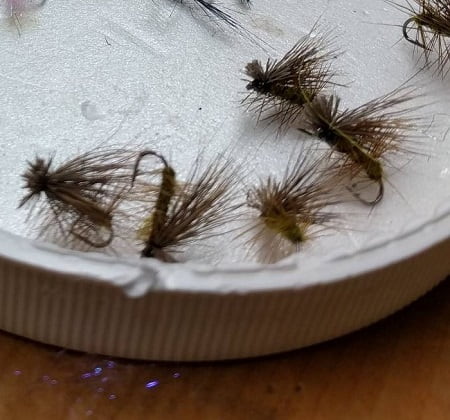
The Elk Hair Caddis is a proven pattern when the caddis are on the water. This pattern is sold just about everywhere that sells flies because it is that good.
You will find variations of this fly in most fly guide boxes.
I have also done well with the CDC Elk Hair Caddis.
15. Stonefly Dry Fly
When it comes to stonefly patterns, the stimulator is one of the most productive and readily available flies.
I tied mine in colors that match the underbody of the stoneflies in my area. This usually means tan or yellow bellies.
This fly is also a great attractor pattern if tied with bright colors like orange and red.
16. Terrestrials
I always have grasshoppers, cricket, and beetle patterns in my box, and there are times when these will be your best dry fly when there’s no hatch.
Make Sure you have these patterns:
Daves Hopper has been a proven fly and one that should be in all angler’s boxes.
The grasshopper can be one of the most effective flies for guides during mid to late summer and you will often see guides targeting deeper river banks for big trout.
Crickets, beetles, and ants also make up the bulk of terrestrial dry flies.
There are times of the year when trout will go crazy during an ant hatch.
Beetles are random and can be fished at any time from spring to fall with good success.
17. Attractor Patterns
Attractor patterns don’t really look like the natural aquatic insects, but they do get the trout’s attention and they can be excellent if there is faster water or when there is no hatch going on.
Flies like the:
Many years ago, one of the top guides in my area told me his number one go-to fly was the usual. Even when all the other anglers were using more imitation patterns, he would still out-fish them with the Usual Fly.
Emergers For Trout
Emergers are the stage of insects as they are turning from a nymphs to an adult. Good merger patterns sit low in the water but have enough of the fly exposed so the anglers can see the fly.
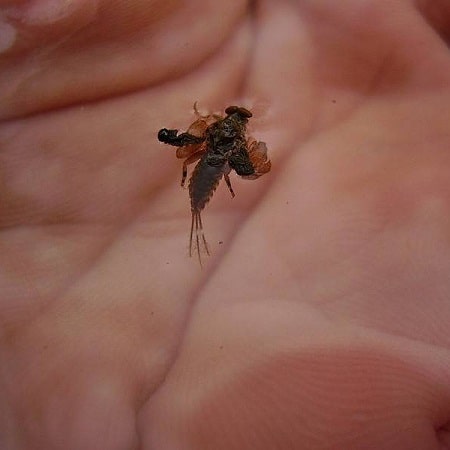
Anglers will use emerged patterns to imitate Caddis and Mayflies.
From catching many emergers, I have learned that natural insects are a mess, with wing casings, shucks, and tails all over the place due to the different stages of emergence. For this reason, your emerger fly doesn’t need to be perfect.
And often, the more beat up my emerger fly is the better it works.
Flies like this Turkey Quill Emerger are go-to flies for me and other guides.
Deer Hair Emergers are often easy to fish and are also a great option.
More Dry Fly Patterns
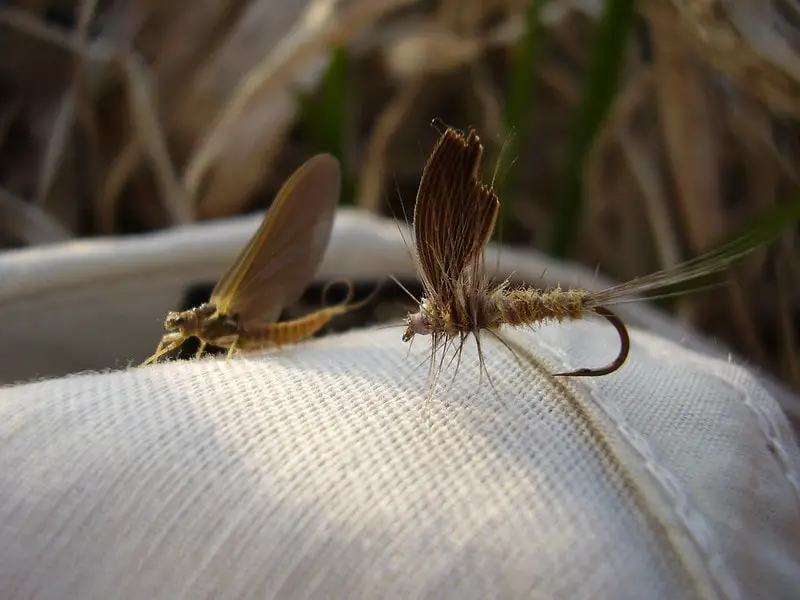
Related Articles
- 21 best dry flies for trout.
- best hooks for fly tying.
- Best Fly Floatants: Tested
Tight Lines,
Graham
References:
Restoration Ecology: Bioenergetic responses of a stream food web to habitat restoration: interactions between Brown trout and invertebrate prey resources

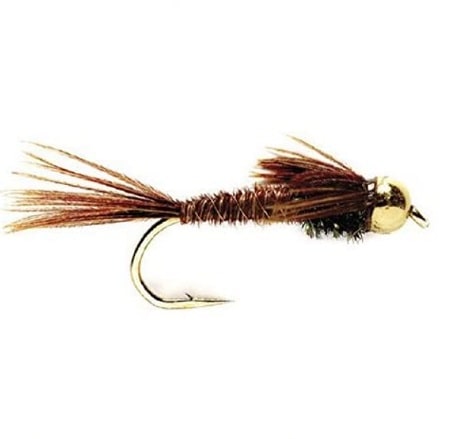
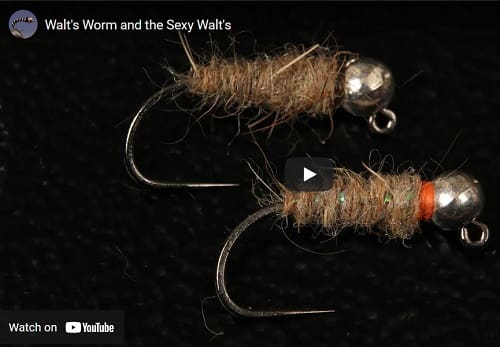
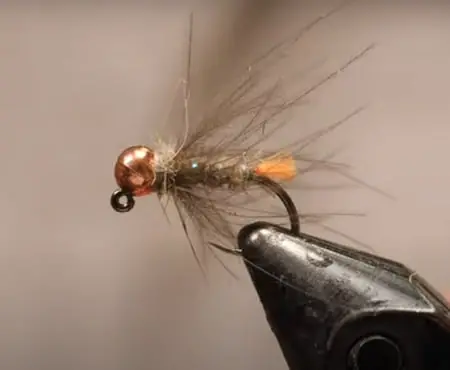
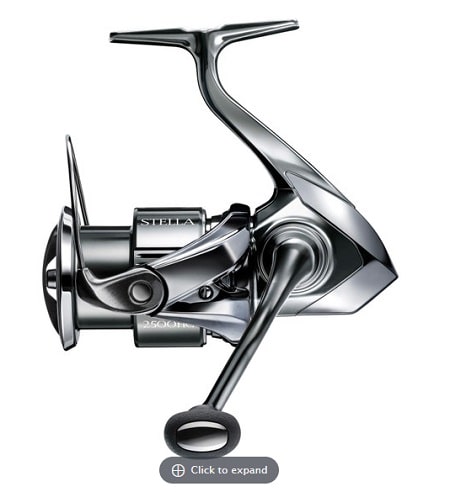
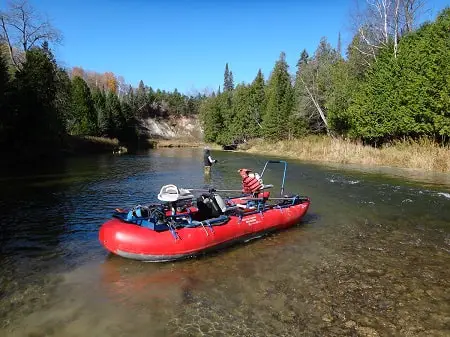
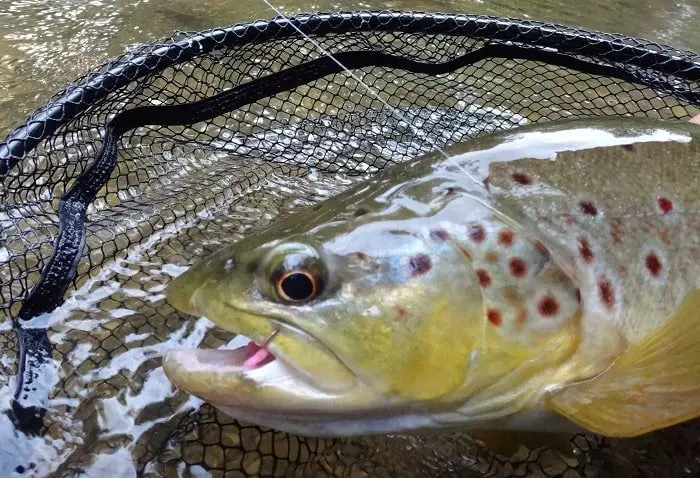
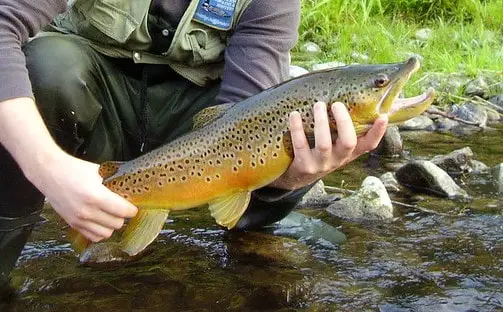
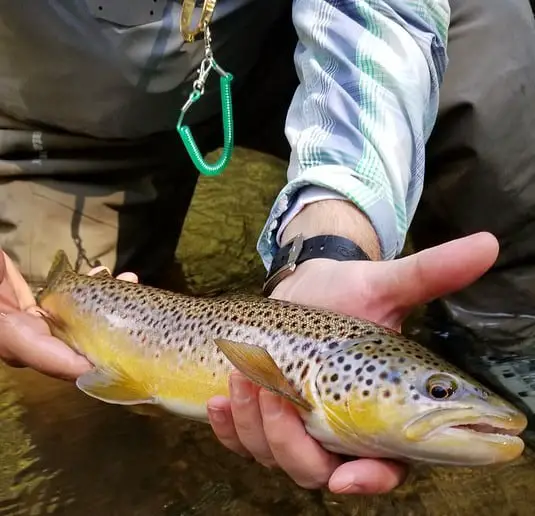
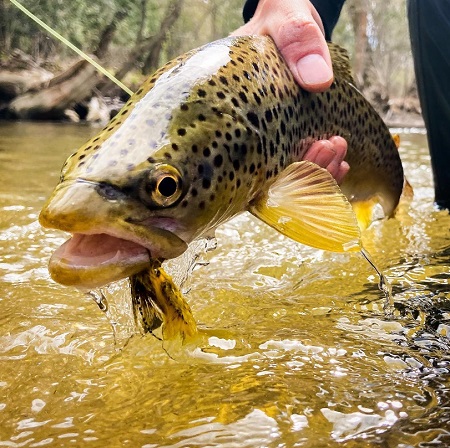
Hello Graham,can you please help me to find good hooks barbed for fly tying,specially for this 29 + above. I must say again that your website are the best.
Hi Faruk,
Sorry for the delayed response, I was away on a backwoods fishing trip with no internet. Also, I had a pre-written but not published article on fly tying hooks which I just published just for you 🙂 Check it out at Best Fly Tying Hooks.
Good Luck Buddy,
Graham
Hello Graham,
I know this is your personal lint fly creation and caddis Pupae pattern. If possible are you willing to share this recipe? If not I do completely understand. Thank you regardless for all the help you have provided on this website 🙂
I will likely have a video if this one day, but i’m pretty busy right now. The lint fly is tied similar to other scud patterns,
Lint Fly:
Thread – Grey or black
Ribbing – Clear mono
Body – 70% Natural Hares Ear plus dubbing 30% cut up deer hair to create the leggy look. Trim to shape when the fly is done. About
Back – Natural turkey quill.
My Caddis Pupae
Thread # 8 Black
Body – green thread – or dubbing
Wing – Black Rafia
Legs #8 or #6 Camel or brown thread.
Colar – dark hairs ear dubbing
Hope that helps
Graham